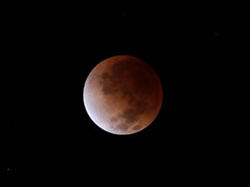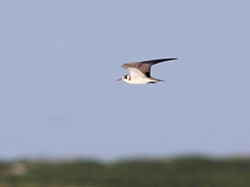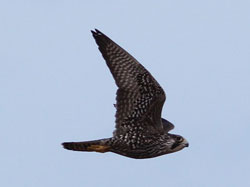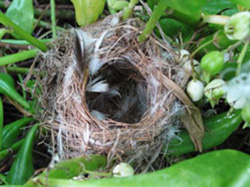2011 Update on the Nihoa Millerbirds on Laysan Island
– New Hope for Critically Endangered Species
The Millerbird Translocation Project is a partnership of the U.S. Fish and Wildlife Service and American Bird Conservancy within the Papahānaumokuākea Marine National Monument and World Heritage Site. The Monument is managed by the Departments of Interior and Commerce and the State of Hawai'i as Co-Trustees.
New Beginnings
December 20, 2011 - January 2, 2012
By FWS Monitoring Team on Laysan Island: Cameron Rutt and Robby Kohley
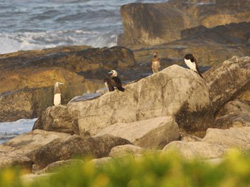
Brewster's boobies (with whitish heads), a subspecies of brown booby that is uncommon in Hawaii. Credit: C.L. Rutt
Twenty-twelve - a new year. What better chance to participate in the decidedly human act of extracting ourselves from the present, to simultaneously reflect upon the past and gaze into the future. If millerbirds were to join us in such visionary festivities, our batch of 24 translocated birds would have much to contemplate. Last year's calendar swap found them in the familiar steep, rocky terrain of Nihoa, 628 miles (1,047 km) away - quite a leap for this sedentary species. Now 2012 finds them among new neighbors in a faraway place, but doing exactly what millerbirds have always done. Since they're evolutionarily shortsighted, we'll look ahead for them. It isn't hard to envision a successful 2012, with the abundance of time necessary for them to reclaim that precise niche that we deprived Laysan of nearly a century ago. And in line with our humanity, we ponder what sort of musings might be shared this time next year. The millerbirds, however, haven't passed the time idly. We've now seen multiple individuals in heavy molt - particularly tail molts - no doubt in preparation for the upcoming bout of breeding that is sure to ensue.
If we thought the days of nomadic millerbirds on Laysan were behind us, then B/S, B/W (blue over silver left, blue over white right) provided us with a friendly wake-up call. Starting in mid-September, this obliging male set up shop at a reliable location in the northeast corner of the island. It was there that he found a mate, built a nest (which, unfortunately, was depredated), and remained, last seen in lackluster fashion on 11/28. This guise of routine and complacency did not prepare us for his reappearance, 12/22, in the southernmost vegetation of the island, for the largest distance between successive resights - 1.43 miles (2.39 km). Needless to say, we were floored.
On December 24th, Laysan's inhabitants banded together for the island-wide Christmas Bird Count. Albatrosses aside, we tallied just shy of 10,000 individual birds, recording 32 species, 1 identifiable subspecies, and 4 hybrid albatrosses. As if knowing that this was an important day - that we were, quite literally, counting on it being there - the Short-tailed Albatross timed its first absence flawlessly, and was missed! Despite this shortcoming, it was a great day and the weather teamed up with an impressive effort to produce nearly all of the unusual birds that had been accumulating. Beginning nearly an hour before sunrise and not finishing until four hours after sunset, Cameron traversed more than 16 miles. Robby even managed two millerbird resights (this was supposed to be a day off!?), for what, in all likelihood, marks the first time this species has ever graced a Christmas Bird Count checklist (in all, four were found).
Finally: the Lesser Frigatebird made a timely comeback (12/23, 12/24, and 1/1); early morning visits to the South Ledges have now produced three (!) "Brewster's" Brown Boobies (Figure 1; 12/22, 12/24, and 12/26); the high count for Northern Pintails (through 12/24) has stayed at 18; the single American Wigeon remains (through 12/24); the content Peregrine Falcon (through 1/1) continues to showcase its abilities (totaled scraps now from 13 Pacific Golden-Plovers, 14 Ruddy Turnstones, and 1 Laysan Finch); a new high count for Sanderlings was achieved (87 on 12/29); and the Gray-tailed Tattler (through 12/24), Wood Sandpiper (through 1/1), Sharp-tailed Sandpipers (through 12/28; only two birds appear willing to stick it out for the winter), Dunlin (through 12/24), and Ruff (through 12/27) all continue.
The Nest that Eclipsed the Rest
December 6 - December 19, 2011
By FWS Monitoring Team on Laysan Island: Cameron Rutt and Robby Kohley
It is not without disappointment that we tentatively wrap up the 2011 fall/winter breeding season. Despite our best wishes and increasingly hopeful expectations, it was simply not to be. Regretfully, the final nest that we had been monitoring stalled midway through the nestling period, with two dead nestlings the only thing to show for all of the parental hard work. Moments like this call for some reflection, in order to gain proper perspective. After all, this last nest ushered eggs, followed by nestlings, successfully through 3.5 weeks - our best nest yet. It is important to note, too, that millerbirds are not known to breed at this time of year, with no prior breeding evidence during the entire months of October, November, and December. Furthermore, nobody anticipated a full-fledged breeding season this soon after the translocation, with nest-building from more than half of all pairs and eggs laid by more than a third. So it is with renewed eagerness that we look towards February and March, a season with increased insect abundance, wintry weather fading out-of-style, and with the birds' normal annual rhythms restored. If the millerbirds build upon this promising start, we see only smooth waters in store for 2012.
With resights becoming more infrequent, it is not uncommon nowadays for birds to escape our notice for a few consecutive weeks. This installment's "resight of the week" goes to four such birds that we happily crossed paths with during the past work period. The following is a list of each bird's color combination, followed by the number of days since we had last bumped into them: R/Y, G/S (28 days), B/G, G/S (31 days), B/S, O/O (36 days), and O/O, O/S (40 days). Hopefully this much time will not pass before we next get a sneak peek into their lives. In some ways, it is hard to believe that for these millerbirds - and for that matter, us - today marks their 100th day on-island (in other ways, this is not so unbelievable!). We've now surpassed the halfway point of our "human" winter tour; on the other hand, when it comes to the millerbirds, Laysan is playing for keeps.
At a place where the term "light pollution" is meaningless, Laysan provided us backstage passes to the lunar eclipse on 12/10 (Figure 1), as most of the crew nearly pulled all-nighters to watch the show develop (total eclipse began here shortly after 4:00 AM local time). The other rare sight was a surprise Black Tern (Figure 2; on the late dates of 12/12 – 12/13) which, according to the Pyle and Pyle monograph, has only wound up in the Northwestern Hawaiian Islands three times prior and is just Laysan's second! For the first time since we discovered it, we did not see the male Lesser Frigatebird during the past two weeks (last seen 11/30) – apparently it has found another vantage point, one that nicely excludes us. Finally: the 18 Northern Pintails remain (through 12/15), with more males "turning" up; the single American Wigeon persists (through 12/12); the lingering Peregrine Falcon continues to exhibit a refined taste for shorebirds (so far, wings from 8 Pacific Golden-Plovers and 10 Ruddy Turnstones (through 12/19)); and the Gray-tailed Tattler (through 12/11), Wood Sandpiper (through 12/6), Sharp-tailed Sandpipers (through 12/6; dwindling to only two birds), Dunlin (through 12/6), and Ruff (through 12/6) all continue.
Nestling in for the Winter
November 22 - December 5, 2011
By FWS Monitoring Team on Laysan Island: Cameron Rutt and Robby Kohley
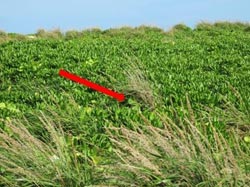
This photo indicates the location of the active nest within the nest substrate, which is, in fact, a clump of Eragrostis. Credit: C.R. Kohley
Like any good fireworks, the finale of the 2011 fall/winter millerbird breeding season was well worth the wait. At least one pair has successfully hatched a plan to safeguard their eggs, navigating their nest (Figure 1) all the way through incubation. It is with much anticipation that we officially announce the first genuinely "Laysan" millerbirds in nearly a century - the lone active nest now bearing one or two approximately week-old nestlings! During our latest nest check (12/2), we were able to discern the raised, begging head of at least one nestling, although it is likely that two exist! With every passing day, it is becomingly increasingly difficult to keep our hopes in-check, although we realize that they still have the better part of a week to go before fledging. Nonetheless, the countdown is on. Otherwise, we've been getting skunked by the millerbirds in the field, leaving no doubt that their reputation for being mouse-like is still very well intact. In fact, this past work period we had no less than three days without a resight. The millerbirds are literally shutting us out, that is, if we were keeping score.
With so few resights, it is tough to decide which is our "resight of the week." Although not a resight, per se, overwhelmingly the best candidate is the only one that doesn't have bands - the nestling(s). Second place, however, would have to go to Bk/S, B/O (black over silver left, blue over orange right; #1), who has developed a penchant for showing up in random places, often in the company of yet another male. Bk/S, B/O has debuted in this section of the blog before - due to her soap opera-esque lifestyle, although she now appears to be trying on the single life for fit. This past work period, she made two random appearances in other pairs' territories, each time unexpectedly popping into view without so much as a peep. Throwing blind-folded darts at an island map might be just as likely as our best-made guesses to pinpoint her next location.
According to the Bird Banding Lab's website, the oldest Black-footed Albatross on record is listed at 37 years and 8 months. This, however, will need to be amended as - drum-roll please - Andrea Kristof along with other USFWS Monument Crew resighted a suspiciously old banded bird on 11/25. Thanks to some quick detective work by Alex Wang, we learned that this individual was banded as a chick here on 8 June 1967 (!) - for a minimum age of 44 years and 5.5 months. Robby was especially pleased for the rejuvenating confirmation that, contrary to everyone else's perceptions, he was not the oldest living creature on the island! Finally: the adult male "Brewster's" Brown Booby showed itself 11/26; the male Lesser Frigatebird emerged in-flight over the Great Frigatebird colony just once (11/30); there are now 18 Northern Pintails, with a few "turning into" males (high count 11/26, 12/1, and 12/2); the single American Wigeon continues (through 12/2); the lingering Peregrine Falcon (Figure 2; possibly japonensis) has set up shop at such a location where we can analyze its leftovers (so far, wings from 5 Pacific Golden-Plovers and 3 Ruddy Turnstones (through 12/2)), and the Gray-tailed Tattler (through 11/26), Wood Sandpiper (through 11/26), Sharp-tailed Sandpipers (through 11/26; high count down to only 14 11/24), Dunlin (through 11/27), and Ruff (through 12/4) all made appearances.
Hide-and-Seek
November 8 - November 21, 2011
By FWS Monitoring Team on Laysan Island: Cameron Rutt and Robby Kohley
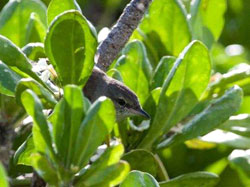
A shy millerbird peeking out of the Scaevola just long enough to be captured by Robby's camera. Credit: C.R. Kohley
Although childhood memories of this game are undoubtedly nostalgic, the millerbirds' version is much less memorable - plenty of the usual hiding and seeking, not so much finding (Figure 1). Lately, the millerbirds have been getting very good at this game and our coevolution has been slow to catch up. Following a first round of exciting, but largely unfruitful, breeding behavior, the birds may now be hunkering down for the winter, to save their reproductive efforts for the more standard breeding season beginning in January or February. What this behavioral change means for us, however, is just that work became a lot harder. Our daily resight spreadsheet now looks less like baseball scores and more like soccer. Despite the downturn in breeding activities, the breeding season that was, is not completely relegated to the past tense. A lone pair has managed to navigate a nest with two eggs successfully past mid-incubation - something to be thankful for - nevertheless, our fingers (and stomachs) remain knotted with each forthcoming nest-check.
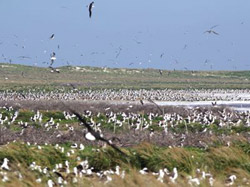
Crowds of Laysan albatrosses beginning the breeding season. Non-breeders attend the colony too, and spend the winter "meeting and greeting" potential mates, dancing together, and sometime practicing nest-building. Credit: C.L. Rutt
Sex changes are by no means a human invention, nonetheless, we were surprised to uncover that the millerbirds had a trick of this nature up their own sleeves. It turns out that that "sly female," B/S, B/G (colored leg-bands blue over silver on the left leg; blue over green on the right leg; #6), that we had mentioned in our last blog post is actually a sly male! Whew. We had stated in late October that "all but one of our apparent females have at one point or another been in association" with a singing male. Well, that one exception had good reason for abstaining from the company of turf-proclaiming males. As luck would have it, we've only chanced upon #6 a handful of times, but this past week (11/17) we found him singing the tell-tale raspy song of a male millerbird, which tips our sex ratio narrowly in favor of males (13:11). Otherwise, the highlight was tracking down an elusive female (with an unfortunate color combination, B/S, B/O; [blue over silver, left; blue over orange, right] #9) that we had searched for repeatedly, but this time unable to elude us (11/16), after a span of 28 unseen days.
Albatrosses continue to dominate the avian scene, with first eggs found during the past two weeks for Black-footed (11/9) and Laysan Albatross (11/16). The combination of their hormone-laced antics and ritualized dances provide constant comic relief, if not for the birds, than at least for us. A nearly island-wide count (11/12) produced a dizzying 12,953 Black-footed and 27,894 Laysan Albatrosses - although not comprehensive as it excluded two regions that together probably held a few more thousand Laysans (Figure 2). That day, our first two apparent Black-footed x Laysan hybrid albatrosses were observed, oddly attractive in their own unique way. The other dominant force is the young Peregrine Falcon (11/4 - 11/21), whose presence, for whatever reason, seems to coincide with the absence of waterfowl and shorebirds. Finally: the adult male "Brewster's" Brown Booby reappeared 11/20; the male Lesser Frigatebird's "regular" roost hasn't been so regular (11/10, 11/15, and 11/17); there are now 17 female Northern Pintails (high count 11/11 and 11/19); a single American Wigeon remains (through 11/19); and the Wood Sandpiper (through 11/16), Sharp-tailed Sandpipers (through 11/16; high count 57 11/12), and Dunlin (through 11/12) continue.
A Finch-Sized Dose of Reality?
October 25 - November 7, 2011
By FWS Monitoring Team on Laysan Island: Cameron Rutt and Robby Kohley
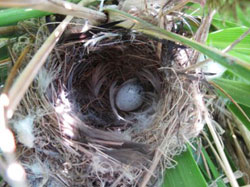
An active Millerbird nest. This clutch was not complete yet; Millerbirds typically lay two eggs. Credit: Cameron Rutt
After the prior two weeks had us all brimming with excited potential, the past two weeks have been tempered with a strong dose of reality. Our first two nests failed during early and mid-incubation (Figure 1). We are uncertain of the exact progression of events, but it seems likely that Laysan Finches depredated these nests. We know that these curious finches have developed a taste for eggs over the millennia of being surrounded by such a smorgasbord of seabird eggs, so unattended eggs are probably a temptation for the finches. The Millerbirds, however, are no stranger to the ways of the finch, having to coexist with its close relative - the Nihoa Finch - over a similarly staggering timeframe. Although easy to forget, we expect these transplanted Millerbirds to exhibit a learning curve here, as they tuck their nests into foreign substrates, fine-tuning the most successful breeding strategy. With this in mind, we look optimistically to the future, in hopes of more nests soon trying to slip eggs past the inquisitive finches. After our first wave of nest-building, we are currently tracking three nests either still underway or recently completed. The old adage which forewarns against keeping all of one’s eggs in a single basket takes on new meaning for us here.
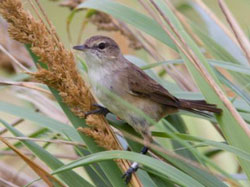
The Millerbird with her colored bands is perched in the native bunch grass Eragrostis variabilis. Credit: C.R. Kohley
This installment's "resight of the week" goes to a sly female, B/S, B/G (#6) [B/S, B/G = leg band combination blue color band over metal (silver) numbered band on the left leg, and blue over green on the right leg], who, despite our best efforts, has been very difficult to locate (last seen 9/20, 45 days prior!). After many hours of fruitless searching, she at last materialized 11/4, silently foraging in another pair's territory. And in what is developing into an avian soap opera of sorts, G/Bk, O/S (#3) [green over black left, black over silver right] and Bk/S, B/O [black over silver left, blue over orange right] (#1; Figure 2) can't seem to settle on a satisfactory territory. This is the fourth male that Bk/S, B/O has shown apparent interest in, so either she is very particular, or the males generally find her unappealing (only time will tell…). After leaving the Southeast Ridge for No Man's Land, the pair has once again picked up their bags and was together seen 713 meters away on 11/3! We can only hope their thirst for travel will soon be quenched.
The other main avian news is the momentous return of the albatrosses, all three of them! Black-footed Albatrosses now pepper the once-vacant beaches, Laysan Albatrosses dot the margins of the lake, and the adult Short-tailed Albatross made its much-anticipated arrival 11/2. Additionally: the adult male "Brewster's" Brown Booby resurfaced 10/30; the Lesser Frigatebird continues (through 11/2); there are now sixteen female Northern Pintails (high count 11/6); an American Wigeon appeared (10/26 - 10/27); our second Peregrine Falcon of the season has been terrorizing the shorebird flock (11/4 - 11/7); a juvenile Bar-tailed Godwit stopped by (10/27); the Ruff (through 11/6), Gray-tailed Tattler, (through 11/1), and Wood Sandpiper (through 11/6) continue; the first Dunlin of the season was discovered (10/27 - 11/6); and our high count of Sharp-tailed Sandpipers has now sky-rocketed to 105 (10/30), close to the all-time Hawaiian high count. Lastly, the juvenile Northern Harrier has not been seen since 10/24. [Editor's note: a Northern Harrier has since been observed at Midway Atoll, more than 300 miles northwest of Laysan.]
Eggstravaganza: First Millerbird Eggs on Laysan in 90 years!
October 24, 2011
By FWS Monitoring Team on Laysan Island: Cameron Rutt and Robby Kohley
As exciting and productive as the first month was, if the past two weeks have proven anything, it is that there was no let-down. The Millerbirds, probably assessing their verdant habitat coupled with frequent rains, have wasted no time getting down to business. Although we were initially very pleased with a few material carries and two flimsy structures which would embarrass the word "nest," we can now happily report that their intentions are serious. In the past two weeks we've found six well-formed nests, including one of the aforementioned structures, with five nest lined and in pristine condition. To top it off, an end-of-the day nest check this morning yielded a deposit of two eggs (!!) in our final nest, with the first egg laid either 10/22 or 10/23. As difficult as it may be, we try to remain realistic about the present status of these nesting birds. Obviously, having nests is the first needed step, but this is far from a guarantee of fledglings in the bird world. So it is with bated breath that we continue to monitor these nests, where bouts of bad weather will undoubtedly have us contemplating their safety.
Our "resight of the week" goes to our well-traveled friend, B/S, B/B (#8), who continues to keep us on our toes. Although initially a cause for frustration as he was difficult to track and resight - let alone the seemingly small prospect of him ever finding a mate - he has endeared himself to us now, in much the same way as a mischievous pet. At long last, after returning to the north end of the lake, near the release site, he was again well on his way to the southern tip 10/16. Lo and behold, however, the following morning (10/17) - a mere 22 hours later - it was back almost as far north as a millerbird can go (a span of exactly 2.01 km), attracting the attention of an unpaired female, Bk/S, G/R (#7). We can only wonder about what adventurous stories he must tell.
Millerbirds are not easy to differentiate by sex. This was one of the major hurdles for the translocation, which necessarily calls for an equal sex ratio on Laysan. In order to decide on who made the first cut, the team relied on a discriminant function analysis (DFA), which uses wing chord and tail length to determine sex, with a published 88% accuracy. After six weeks, all of our observations point to a 50/50 split, 12 males and 12 females, with only two mislabeled, for the ideal sex swap, a predicted female and a putative male. We've now observed 12 different males in song and all but one of our apparent females have at one point or another been in association with one of these singing males. So far, we've recognized 11 pairs, although some of the pairs are still fluid, with the remaining two birds hopefully paired off, enjoying their fleeting privacy.
October 12, 2011
By FWS Monitoring Team on Laysan Island: Cameron Rutt and Robby Kohley
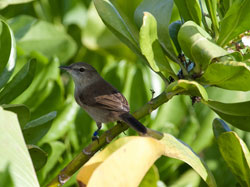
A Nihoa Millerbird watching for unsuspecting insects in the naupaka (Scaevola taccada) on Laysan Island. Note color bands - in addition to a numbered metal band, each bird released on Laysan carries a unique combination of colors to permit identification using binoculars. Credit: Robby Kohley
Following their release here on 10 September, the translocated Nihoa Millerbirds (NIMIs) are off to a great start on Laysan, with one month already under-their-belts. Although it is premature to make any assessments of their long-term viability at this early juncture, we couldn't be happier with the initial results. A full month in and we've already resighted each and every one of the 24 NIMIs at least twice (for a total of 150 resights), despite the last furtive female (Bk/S, G/Y) holding out until early October. In fact, we've managed to resight 22 of the 24 NIMIs (11/12 originally transmittered, 11/12 non-transmittered) within the past six days alone, a particularly successful stretch for us! During this span, we've noted no less than seven male-female pairings, and two pairs have been observed carrying nesting material, with preliminary nest structures already underway. Our early impression is that the millerbirds are tending to cluster in regions of higher density, rather than spreading evenly across their newfound habitat. It also appears that these regions are in the sparser, more segregated clumps of naupaka, with scattered Eragrostris (bunchgrass), rimming the vegetated exterior in the north and northeast.
Prior to release, half (12) of our translocated cohort were outfitted with radio transmitters to allow tracking by telemetry. These signals helped us keep tabs on the birds during the first three to four weeks post-release, a critical time of increased mobility, prior to their eventual territory settlement. Although some birds have quickly found turf to proclaim their own, other individuals are still wandering. The most nomadic individual was most certainly B/S, B/B (#8), who managed to make it all the way to the southern tip of the island (23 September - 5 October; >2 km from the release site), only to be seen the following day at the complete opposite end (6 October)! Tracking the 12 transmittered individuals is now behind us, as all of the batteries have since expired (the last pulse emitted on 7 October), which leaves us with only our eyes, ears, and a lot of hiking ahead.
Along the way, we were also able to document a few rarities that found their way to this speck of land amidst a sea of blue. These included a Lesser Frigatebird (3rd Laysan record), Wood Sandpiper (16 - 26 September; 6th record for Hawaii), Gray-tailed Tattler (25 - 26 September; 9th record for Hawaii), a probable first-cycle Hawaiian Coot (5th Laysan record; separation from similarly-aged American Coot tenuous and not currently resolved). Additionally, two other more regular Asian shorebirds wound up among the many Pacific Golden-Plovers and Ruddy Turnstones: a juvenile Ruff (12 - 19 September) and as many as 23 Sharp-tailed Sandpipers (high count; 8 October).
Release of Nihoa Millerbirds on Laysan Island Offers New Hope for Critically Endangered Species
September 10, 2011
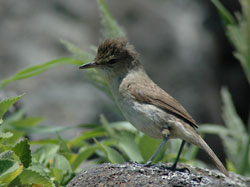
New hope for critically endangered Nihoa Millerbirds with their release on Laysan Island. Credit: Mark MacDonald
In a historic and collaborative effort to save a species from extinction, 24 critically endangered Nihoa Millerbirds were released on Laysan Island in Papahānaumokuākea Marine National Monument on September 10, 2011. The release was the result of many years of research and detailed planning by biologists and resource managers, led by a partnership between the U.S. Fish and Wildlife Service (FWS) and American Bird Conservancy (ABC).
View 2014 Updates.
View 2013 Updates.
View 2012 Updates.
Click Here for photos, videos and more information (you will be directed to a U.S. Fish and Wildlife Service website).
Click Here to view the September 19, 2011 Press Release (2.1mb pdf).
